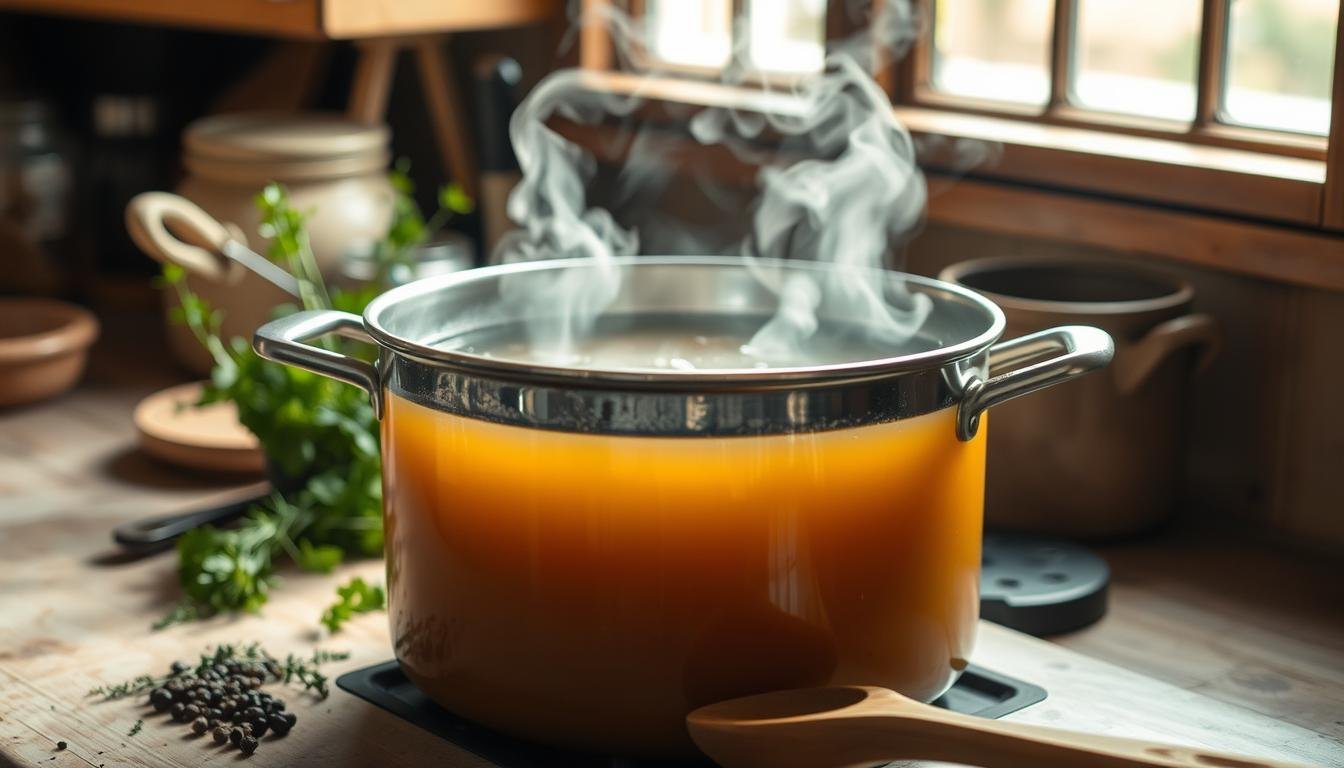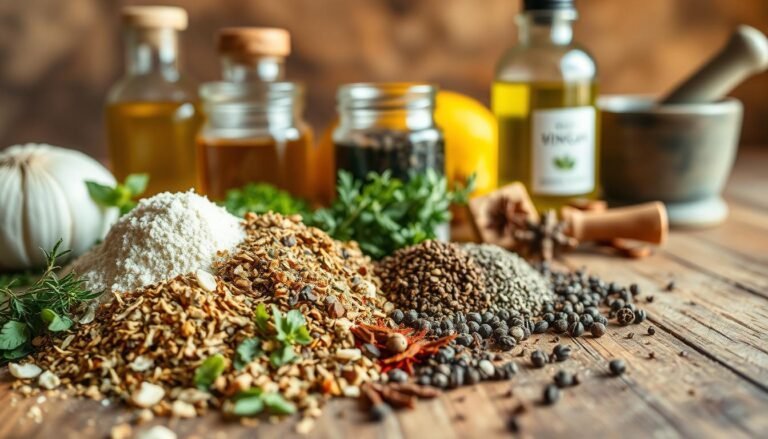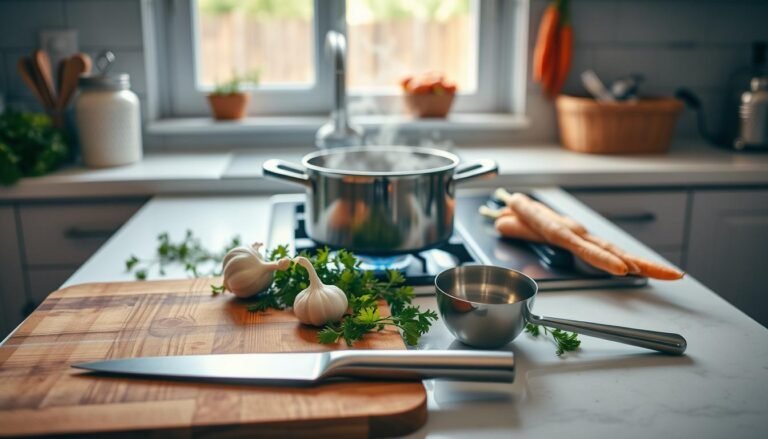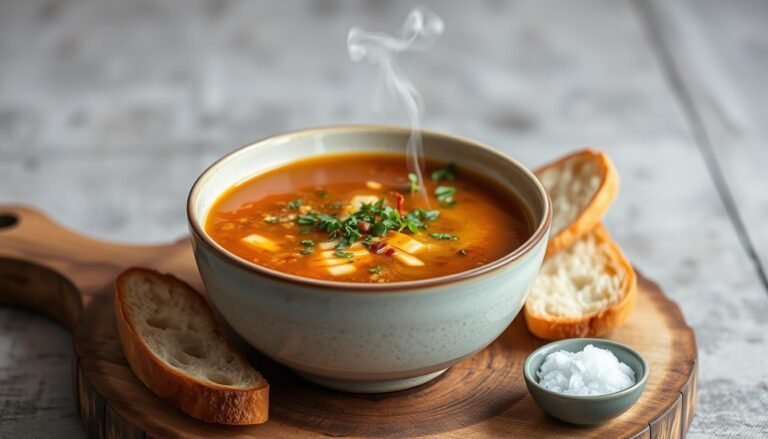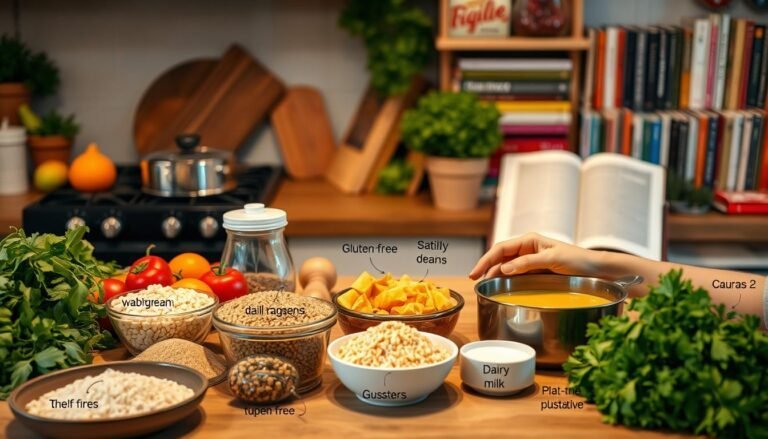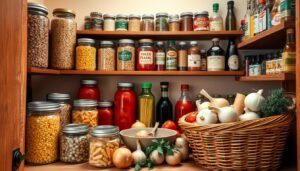Disclosure: This Post Contains Affiliate Links; We earn a commission on purchases.
Making the perfect soup broth is like a work of art. It needs careful attention and a good grasp of its basics. Chef Eric Sze from 886 and Wenwen in New York City says, “Broth is like building a house. You start with a foundation, then add walls and a roof.”
A top-notch broth is the heart of a tasty soup. Getting it right every time is a skill worth learning. By focusing on the key parts of a great broth, you can improve your soup-making. This way, you’ll make dishes that are both healthy and full of flavor.
Key Takeaways
- Understand the foundational elements of a great broth.
- Learn how to lay a foundation for your broth.
- Discover the importance of using quality ingredients.
- Master the technique of simmering for a rich flavor.
- Explore ways to enhance your broth-making skills.
The Foundation of Exceptional Broth
Broth is the base of great soups. Claire Saffitz says a soup’s quality depends on its broth. So, starting with a homemade broth recipe is key.
Understanding the Role of Broth in Soup Making
The broth is more than a liquid. It adds depth, richness, and character to the soup. A good broth can make the whole dish better.
Different Types of Broths and Their Uses
There are many broths, each with its own traits and uses. Knowing these differences helps choose the right broth for your soup.
Meat-Based Broths
Meat-based broths are made from bones, meat, and veggies. They’re rich and flavorful. They’re great for soups like beef stew or chicken noodle soup.
Vegetable Broths
Vegetable broths are perfect for veggie or vegan soups. They’re light but flavorful. You can use many veggies, herbs, and spices to make them.
Fish and Seafood Broths
Fish and seafood broths are light and aromatic. They’re good for soups like bouillabaisse or fish chowder. They cook quickly to keep flavors fresh.
Knowing about different broths and their uses can improve your soup making. Whether it’s a hearty meat broth or a light veggie broth, quality ingredients and care are key.
Selecting the Right Ingredients
Making a tasty broth starts with picking the best ingredients. The quality of your broth depends on what you choose. This step is key in making soup.
Quality Proteins: Bones, Meat, and Seafood
The proteins you pick affect your broth’s flavor. Eric Sze says to choose a main ingredient and get different types for more taste. You can use bones, meat, and seafood, based on your broth type.
Best Bones for Rich Broths
Some bones are better for rich broths. Marrow bones and knuckle bones have lots of collagen. This makes the broth smooth. For clear broth, use beef or veal bones. Chicken bones make a lighter broth.
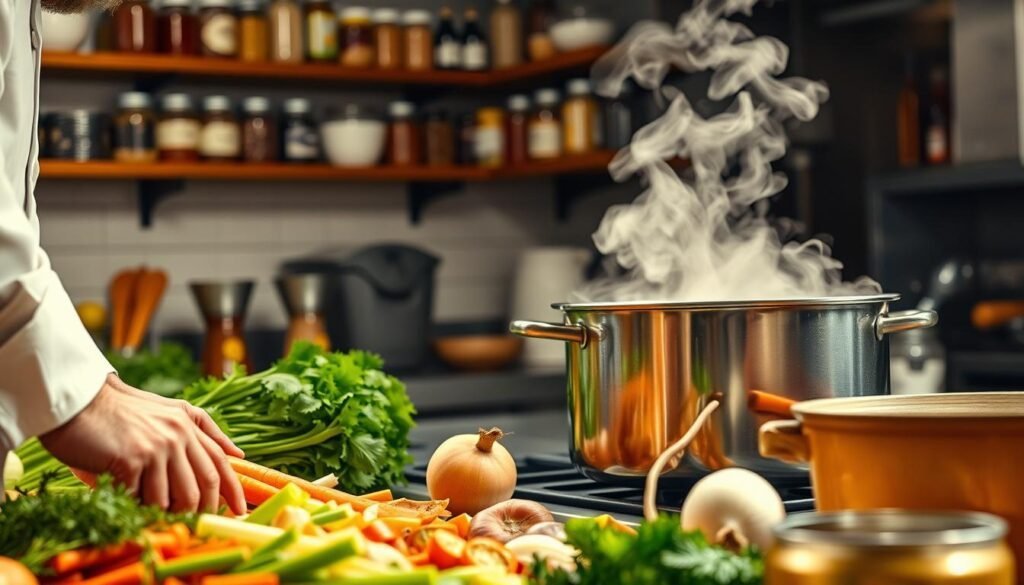
Choosing the right meat also boosts your broth’s taste. Shank or brisket are great for slow-cooking. For seafood broth, fish heads and shells add depth.
Essential Aromatics and Vegetables
Aromatics and vegetables are vital for a tasty broth. Onions, carrots, and celery are common choices. You can also add leeks, garlic, and mushrooms for more flavor.
Herbs and Spices That Elevate Flavor
Herbs and spices make your broth stand out. Bay leaves, thyme, and peppercorns are good choices. For unique flavors, try star anise, coriander, or lemongrass. The goal is to add flavor without overpowering the broth.
Mastering Cooking Techniques
To make a rich broth, you need to learn some key cooking skills. These skills help turn a good broth into a great one. They make the broth clear and full of flavor.
The Art of Simmering vs. Boiling
Simmering is a cooking method that’s often ignored but is very important. It helps make broths deep and flavorful. Unlike boiling, simmering keeps the broth clear and tastes better.
Simmering over boiling is a technique that prevents the broth from becoming cloudy and ensures a cleaner flavor.
Skimming for Clarity and Purity
Skimming is a key step in making broth. It removes impurities that rise to the surface. By skimming often, you keep the broth clear and free from bad tastes.
Regular skimming is key to achieving a clear and pure broth.
Cooking Duration: When to Stop
Knowing when to stop cooking is important. It depends on the ingredients and how strong you want the flavor to be. There are two main things to consider: how long to simmer and when to stop.
Short vs. Long Simmering Times
Short simmering times work best for light broths. Longer times are better for stronger broths. Here are some guidelines:
- Delicate fish broth: 10-20 minutes
- Chicken broth: 30-60 minutes
- Beef or lamb broth: 3-6 hours
Visual and Taste Indicators
Visual and taste clues can tell you when the broth is ready. A good broth tastes rich and looks clear. Here are some signs to look for:
- A rich, intense color
- A flavorful, savory taste
- A clear, not cloudy, appearance
By learning these cooking techniques, you can make your broth better. This makes your soups more enjoyable and satisfying.
Tips for Perfecting Your Soup Broth Every Time
To make a great soup broth, you need to balance flavors and get it clear. A good broth is key to a tasty soup. Several things help make it excellent.
Balancing Flavors: Salt, Acid, and Umami
Getting the flavors right in your broth is key. Think about salt, acid, and umami. Salt brings out the natural tastes. Acid, like tomatoes or citrus, adds brightness. Umami, from mushrooms or soy sauce, adds a savory touch.
- Salt: Enhances natural flavors
- Acid: Adds brightness and depth
- Umami: Contributes a savory flavor
Clarification Methods for Crystal-Clear Broths
A clear broth looks good and shows it’s well-made. There are ways to make it clear:
Egg White Method
The egg white method uses egg whites and cold water or broth. Whisk until frothy, then add to the broth. The egg whites catch impurities, making the broth clear.
Gelatin Filtration
Gelatin filtration works too. Add gelatin to cooled broth and chill. The gelatin and impurities solidify. Remove the gelatin for a clearer broth.
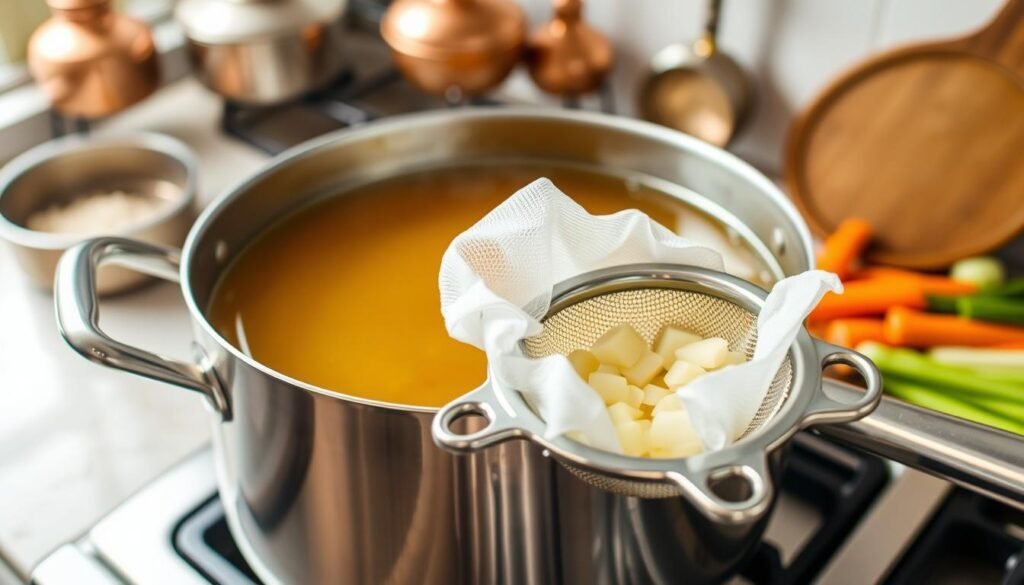
Storage and Reheating Best Practices
Storing and reheating broth right keeps it good. Cool it fast and put it in airtight containers. Reheat slowly to avoid cloudiness or bad tastes.
- Cool the broth quickly
- Store in airtight containers
- Reheat gently
Testing and Adjusting Your Broth
Claire Saffitz says to taste and adjust your broth as you go. This way, you can tweak it to get the perfect flavor.
Tasting Throughout the Process
It’s important to taste your broth often. Start early and keep tasting at regular times. This lets you see if it needs more seasoning or if it’s too salty.
Key elements to focus on while tasting include:
- Flavor depth
- Balance of salt, acid, and umami
- Clarity and purity of the broth
Fixing Common Flavor Issues
Broths can sometimes go wrong. Here’s how to fix common problems:
Too Bland
If it’s too bland, add more aromatics or seasoning. Also, simmer it longer to get more flavor from bones and veggies.
Too Salty
Too salty? Add a bit of sugar or more veggies. If it’s really salty, dilute it with water or unsalted broth.
Bitter Notes
Bitterness can be fixed with lemon juice or a bit of sweetness. Burnt ingredients can cause bitterness, so watch your aromatics.
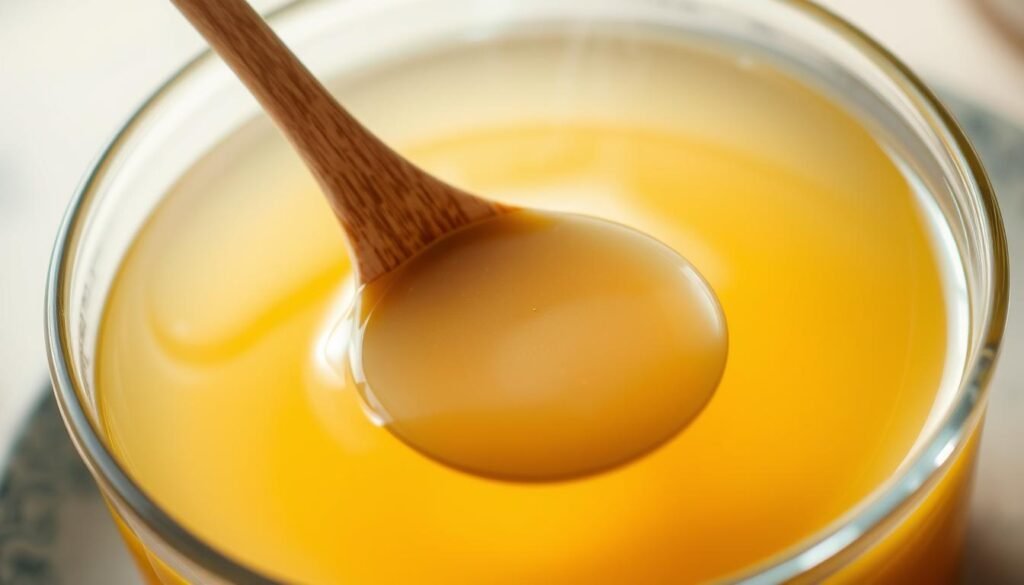
Achieving Balance in Different Soup Styles
Each soup style needs its own flavor balance. Clear broths need less seasoning, while creamy soups can handle more. Know what you’re making to adjust your broth right.
Some tips for achieving balance include:
- For clear soups, keep it clear by skimming often.
- For creamy soups, make sure the broth is rich before adding cream.
- For brothy soups, balance the flavors between broth and solids.
Advanced Broth Techniques for Home Cooks
Home cooks can learn advanced broth-making methods to improve soup flavor. These techniques can turn a simple soup into a masterpiece.
Roasting Components for Deeper Flavor
Roasting bones and vegetables before making broth adds depth. Eric Sze’s method is great for richer flavors. Just roast your bones and veggies at high heat until browned, then make your broth.
Infusion Methods
Infusion is a technique that boosts broth flavor. It involves steeping ingredients like herbs and spices in the broth. For example, adding herbs like parsley or thyme can add a unique taste.
International Broth Variations to Try
Trying international broth variations can also enhance soup flavor. Each culture has its own broth-making style, using local tastes and ingredients.
Asian Dashi and Bone Broths
In Asian cooking, dashi broth is key. It’s made by infusing seaweed and dried bonito flakes in water. It’s light but full of umami. Bone broths are also used for their flavor and nutrition.
European Consommés
European, like French, cuisine is famous for consommé. It’s a clear broth made with beef or chicken stock and egg whites. This method improves flavor and makes the broth clear.
Middle Eastern Stock Techniques
Middle Eastern stocks are flavored with spices like cumin and coriander. These stocks are bases for many soups and stews.
Using these advanced broth techniques can greatly improve your soups. It also lets you explore many culinary traditions.
Conclusion
Making the perfect soup broth is like an art. It needs detail, the right stuff, and practice. By learning the soup stock secrets in this article, you’ll make soups that wow everyone.
To make a great broth, pick quality proteins, aromatics, and veggies. Learn to simmer and skim well. And remember, taste and adjust as you go to get the flavors right.
With these tips, you’re on your way to making soups that are healthy and tasty. Try new things and find your own style. Enjoy the journey of making your soup broth better.
FAQ
What is the key to making a great soup broth?
What are the different types of broths and their uses in cooking?
How do I choose the best ingredients for my broth?
What is the difference between simmering and boiling, and why is it important?
How can I achieve a crystal-clear broth?
How do I balance flavors in my broth?
What are some advanced techniques for enriching broth flavor?
How should I store and reheat my broth?
How can I fix common flavor issues in my broth?

Ryan Conlon is the comfort food fan behind QuickSimpleSoups.com, where he shares easy soup ideas, smart shortcuts, and helpful tips for busy home cooks. Ryan believes a good bowl of soup doesn’t need to be complicated—and he’s here to prove it. Whether you’re looking for quick weeknight meals or cozy classics with a twist, Ryan’s simple approach helps you serve up satisfying soups with minimal effort.
Subscribe to Our Newsletter

